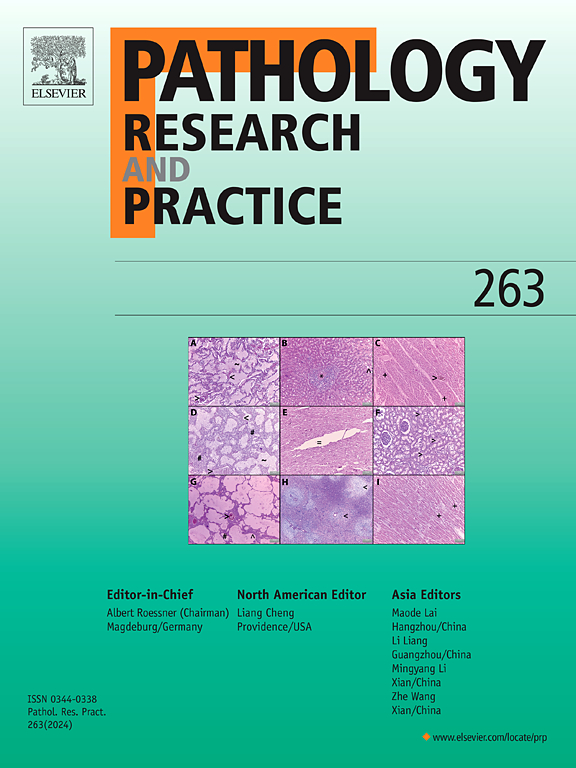评估 SOCS3 在急性心肌梗死铜代谢中的诊断潜力。
IF 2.9
4区 医学
Q2 PATHOLOGY
引用次数: 0
摘要
急性心肌梗死(AMI)是一种危急的心血管疾病,需要快速、精确的诊断策略。本研究探讨了铜代谢平衡相关基因对急性心肌梗死的诊断意义。我们从 Genecards 和 GEO 数据库中发现了与铜代谢和 AMI 相关的基因,并通过 R 软件进行了差异基因分析。通过基因本体(GO)和京都基因组百科全书(KEGG)富集分析对基因功能进行了注释,而 STRING 数据库则通过拓扑分析帮助识别了关键基因。利用 ROC 曲线分析评估了这些基因的诊断价值,尤其是细胞因子信号转导 3(SOCS3)。通过体外和体内模型,包括心肌细胞缺氧/再氧合(H/R)和大鼠心肌梗死(MI)模型,验证了 SOCS3 的表达。此外,我们还研究了 SOCS3 基因敲除对细胞增殖、凋亡和心肌梗死严重程度的影响。结果发现了 77 个基因,其中 73 个基因上调,4 个基因下调。这些基因主要参与细胞因子活化、炎症调节和脂质代谢相关通路。网络分析突出了 10 个关键基因,其中 SOCS3 具有显著的诊断潜力(AUC > 0.9)。验证实验证实了 SOCS3 在疾病模型中的过度表达,敲除 SOCS3 可减少细胞凋亡、缩小梗死范围并改善心脏功能。这项研究强调了铜代谢相关基因(尤其是 SOCS3)在急性心肌梗死中的诊断意义。这些发现为了解急性心肌梗死的分子机制提供了新的视角,有助于开发有针对性的诊断和治疗策略。本文章由计算机程序翻译,如有差异,请以英文原文为准。
Evaluating the diagnostic potential of SOCS3 in copper metabolism for acute myocardial infarction
Acute myocardial infarction (AMI) represents a critical cardiovascular condition necessitating rapid and precise diagnostic strategies. This study investigates the diagnostic implications of genes involved in copper metabolism homeostasis in AMI. We identified genes related to copper metabolism and AMI from Genecards and GEO databases, conducting differential gene analysis via R software. Gene function was annotated through Gene Ontology (GO) and Kyoto Encyclopedia of Genes and Genomes (KEGG) enrichment analyses, while the STRING database facilitated key gene identification via topological analysis. The diagnostic value of these genes, particularly cytokine signaling 3 (SOCS3), was assessed using ROC curve analysis. SOCS3 expression was validated using in-vitro and in-vivo models, including cardiomyocyte hypoxia/reoxygenation (H/R) and rat myocardial infarction (MI) model. Further, we examined the effects of SOCS3 knockout on cell proliferation, apoptosis, and myocardial infarction severity. 77 genes were identified, with 73 showing upregulation and 4 downregulation. These genes mainly participated in pathways related to cytokine activation, inflammation regulation, and lipid metabolism. Network analysis highlighted 10 key genes, with SOCS3 exhibiting significant diagnostic potential (AUC > 0.9). Validation experiments confirmed SOCS3 overexpression in disease models, with its knockout leading to decreased apoptosis, reduced infarct size, and improved cardiac function. This study highlights the diagnostic relevance of genes associated with copper metabolism, particularly SOCS3, in AMI. These findings offer novel insights into the molecular mechanisms of AMI, supporting the development of targeted diagnostic and therapeutic strategies.
求助全文
通过发布文献求助,成功后即可免费获取论文全文。
去求助
来源期刊
CiteScore
5.00
自引率
3.60%
发文量
405
审稿时长
24 days
期刊介绍:
Pathology, Research and Practice provides accessible coverage of the most recent developments across the entire field of pathology: Reviews focus on recent progress in pathology, while Comments look at interesting current problems and at hypotheses for future developments in pathology. Original Papers present novel findings on all aspects of general, anatomic and molecular pathology. Rapid Communications inform readers on preliminary findings that may be relevant for further studies and need to be communicated quickly. Teaching Cases look at new aspects or special diagnostic problems of diseases and at case reports relevant for the pathologist''s practice.

 求助内容:
求助内容: 应助结果提醒方式:
应助结果提醒方式:


